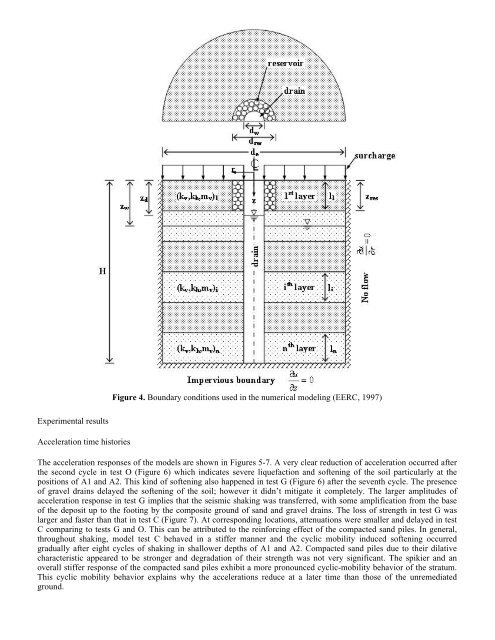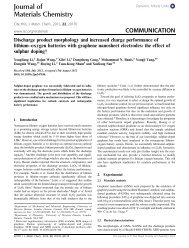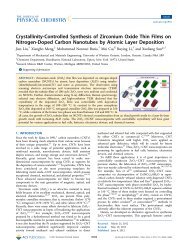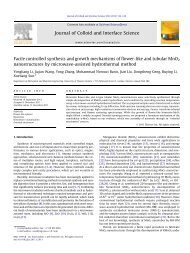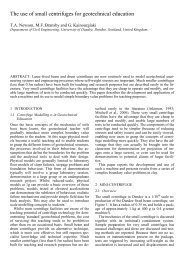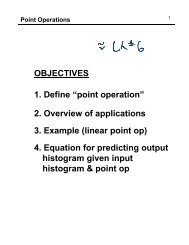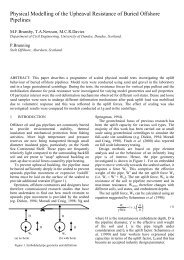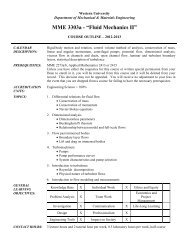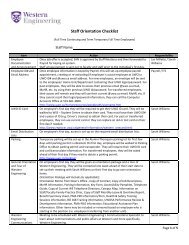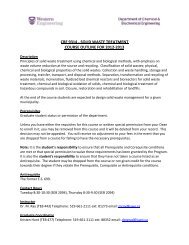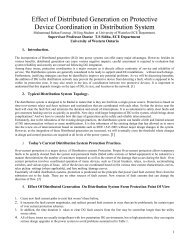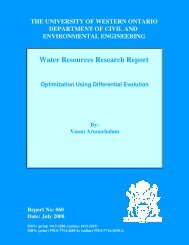Seismic Behavior of Gravel Drains and Compacted Sand Piles using ...
Seismic Behavior of Gravel Drains and Compacted Sand Piles using ...
Seismic Behavior of Gravel Drains and Compacted Sand Piles using ...
You also want an ePaper? Increase the reach of your titles
YUMPU automatically turns print PDFs into web optimized ePapers that Google loves.
Experimental results<br />
Acceleration time histories<br />
Figure 4. Boundary conditions used in the numerical modeling (EERC, 1997)<br />
The acceleration responses <strong>of</strong> the models are shown in Figures 5-7. A very clear reduction <strong>of</strong> acceleration occurred after<br />
the second cycle in test O (Figure 6) which indicates severe liquefaction <strong>and</strong> s<strong>of</strong>tening <strong>of</strong> the soil particularly at the<br />
positions <strong>of</strong> A1 <strong>and</strong> A2. This kind <strong>of</strong> s<strong>of</strong>tening also happened in test G (Figure 6) after the seventh cycle. The presence<br />
<strong>of</strong> gravel drains delayed the s<strong>of</strong>tening <strong>of</strong> the soil; however it didn’t mitigate it completely. The larger amplitudes <strong>of</strong><br />
acceleration response in test G implies that the seismic shaking was transferred, with some amplification from the base<br />
<strong>of</strong> the deposit up to the footing by the composite ground <strong>of</strong> s<strong>and</strong> <strong>and</strong> gravel drains. The loss <strong>of</strong> strength in test G was<br />
larger <strong>and</strong> faster than that in test C (Figure 7). At corresponding locations, attenuations were smaller <strong>and</strong> delayed in test<br />
C comparing to tests G <strong>and</strong> O. This can be attributed to the reinforcing effect <strong>of</strong> the compacted s<strong>and</strong> piles. In general,<br />
throughout shaking, model test C behaved in a stiffer manner <strong>and</strong> the cyclic mobility induced s<strong>of</strong>tening occurred<br />
gradually after eight cycles <strong>of</strong> shaking in shallower depths <strong>of</strong> A1 <strong>and</strong> A2. <strong>Compacted</strong> s<strong>and</strong> piles due to their dilative<br />
characteristic appeared to be stronger <strong>and</strong> degradation <strong>of</strong> their strength was not very significant. The spikier <strong>and</strong> an<br />
overall stiffer response <strong>of</strong> the compacted s<strong>and</strong> piles exhibit a more pronounced cyclic-mobility behavior <strong>of</strong> the stratum.<br />
This cyclic mobility behavior explains why the accelerations reduce at a later time than those <strong>of</strong> the unremediated<br />
ground.


